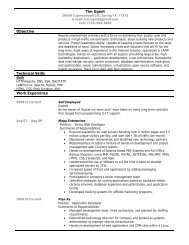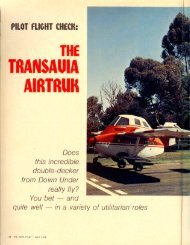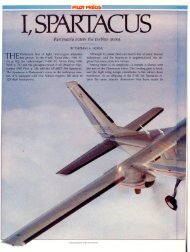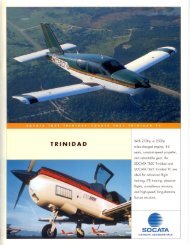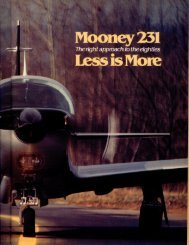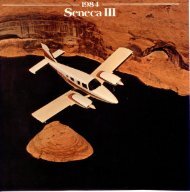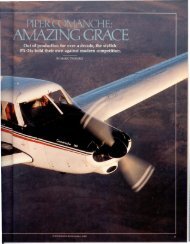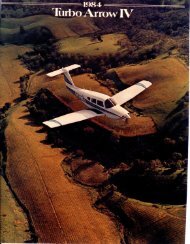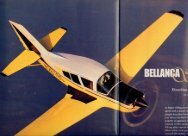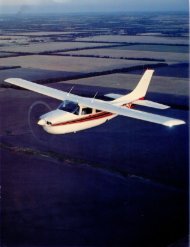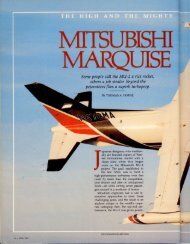A Merlin by any other name - Aero Resources Inc
A Merlin by any other name - Aero Resources Inc
A Merlin by any other name - Aero Resources Inc
- No tags were found...
You also want an ePaper? Increase the reach of your titles
YUMPU automatically turns print PDFs into web optimized ePapers that Google loves.
accelerated to a cruise climb speed of180 knots. Rate of climb averaged2,000 fpm up through 16,500 feet,where we leveled off to try a variety ofconfiguration changes, slow flight,missed approaches, simulated enginefailure and stalls. It is a big, stable aircraft.Control forces are high, but the300 maneuvers well. At the stall, thestick pusher wakes you up with a pronouncedyank on your arms.The only problem I had with it wascaused <strong>by</strong> the different shape of thepower levers. The left lever knob is adifferent shape and larger than theright. My lack of familiarity with theaircraft caused me regularly to applydifferential thrust. When you do thatwith all the power available, and thoselarge propellers, you know you havedone something wrong. On onebalked landing simulation, I thoughtinitially that I had lost an engine. It is,as they say, an attention grabber.After a simulated emergency descent,we went to Dulles to shoot approaches.There was a good mix oflight and heavy traffic that day that resultedin approach giving us severalrunway changes and two go-aroundsthat provided realistic demonstrationsof the 300's behavior in high-density,distracted conditions. It did well.The return to Frederick involved an<strong>other</strong>balked landing. On the secondtry, I intentionally set up an unstabilizedfinal approach at just above minimumapproach speed to see what itfelt like. On short final, with full flaps,I again applied asymmetric power. Justas I was about to call a missed approach,Milner asked with a touch ofnervousness: "Do you want a missedapproach?" At that point, I sure did.The next morning we flew a photomission with N447SA, which providedan<strong>other</strong> opportunity to sample relativelylow speed, maneuvering characteristics,do some more takeoffs andlandings and just nose around the airplanewhile Pilot creative director ArtDavis was taking static shots. My offerto take it with me the next day on abusiness trip to the West Coast was forsome reason rejected.It would have been great to havehad a chance to fly the 300 in the missionfor which it was designed: longdistance, high altitude cruising. Stillair range at maximum cruise power at26,000 feet is almost 2,200 nauticalmiles; true airspeed 275 knots. It is theright way to go cross country. 0Swearingen Metro. A 19- to 20-passenger stretched version ofthe <strong>Merlin</strong> III was introduced in 1969. The <strong>Merlin</strong> IV, a corporateversion of the Metro with luxo-interior for 11 to 15 passengers,was introduced the following year. The Metro was developed as ajoint venhue with Fairchild Hiller. In 1971, Swearingen Aircraftbecame a subsidiary of Fairchild.Fairchild 300. Introduced in 1983, replacing the <strong>Merlin</strong> I1Ie. the300's major distinguishing feature is a new pair of winglets, designedto reduce spanwise airflow and drag. Garrett 900-shp enginessupply the power. Maximum speed is 300 knots.<strong>Merlin</strong> me. The <strong>Merlin</strong> IlIA and IIIB increased in power andweight until the 12,SOO-pound weight limit for aircraft certificatedunder Federal Aviation Regulation Part 23 was reached with theI1IB.The <strong>Merlin</strong> I1IC and Metro III were certificated under a newset of standards, Special Federal Aviation Regulations Part 41,which is more stringent than FAR Part 23 but less stringent thanFAR Part 25, the regulation for transport aircraft. SFAR 41 allowsgross weights of more than 12,500 pounds, but sets higher standardsfor single-engine performance and requires certain safetyfeatures, such as engine fire extinguishers. The pilot in commandof an SFAR Part 41 certificated aircraft must have a type rating,and two pilots generally are required under these rules. (The aircraftcan be operated under FAR Part 23 if gross weight is lessthan 12,500 pounds.) Most of the differences in the <strong>Merlin</strong> I1IC arenot readily apparent to the eye. It has a maximum takeoff weightof 13,230 pounds and a maximum cruise of 300 knots.Fairchild 400. The 400, an updated <strong>Merlin</strong> IV, boasts 347-knotplusspeeds (400 mph) and is powered <strong>by</strong> two Garrett TPE 331-141,100-shp engines turning Dowty Rotol propellers. Certification isexpected in late 1985.Swearingen 5X300. The SX300 is an aluminum kit-built airplaneintended to be powered <strong>by</strong> a 300-hp Lycoming 10-540 engine.Projected cruise speed, according to Ed Swearingen, will be 239knots at 7S-percent power and 8,000 feet. First shipments arescheduled for mid-1984.-J.Jefferson MillerAOPA PILOT. 71



